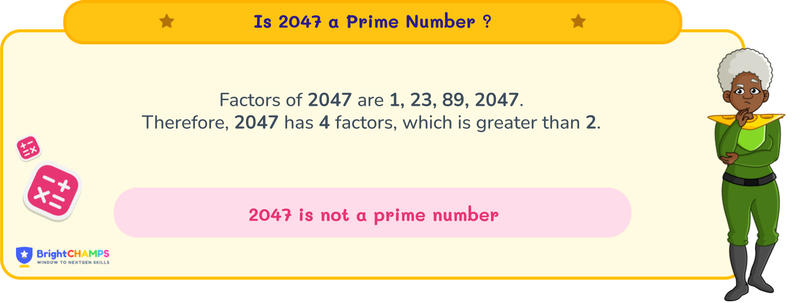Summarize this article:
 188 Learners
188 LearnersLast updated on 5 August 2025
Is 2047 a Prime Number?

Prime numbers are numbers that have only two factors, which are 1 and itself. They play a crucial role in encryption, computer algorithms, and other fields. In this topic, we will be discussing whether 2047 is a prime number or not.

Is 2047 a Prime Number?
Numbers can be categorized as prime or composite based on their factors.
A prime number is a natural number that is divisible only by 1 and itself. For example, 11 is a prime number because it is divisible by only 1 and 11.
A composite number is a positive number that is divisible by more than two numbers. For instance, 12 is divisible by 1, 2, 3, 4, 6, and 12, making it a composite number.
Prime numbers have specific properties:
Prime numbers are positive numbers always greater than 1.
2 is the only even prime number.
They have only two factors: 1 and the number itself.
Any two distinct prime numbers are co-prime numbers because they have only one common factor, which is 1.
Since 2047 has more than two factors, it is not a prime number.


Why is 2047 Not a Prime Number?
The defining characteristic of a prime number is that it has only two divisors: 1 and itself. Since 2047 has more than two factors, it is not a prime number. Several methods can be used to distinguish between prime and composite numbers, such as:
- Counting Divisors Method
- Divisibility Test
- Prime Number Chart
- Prime Factorization

Using the Counting Divisors Method
The counting divisors method involves counting the number of divisors to categorize numbers as prime or composite. Based on the count of divisors:
If there is a total count of only 2 divisors, then the number is prime.
If the count is more than 2, the number is composite. Let’s check whether 2047 is prime or composite.
Step 1: All numbers are divisible by 1 and itself.
Step 2: Divide 2047 by 2. It is not divisible by 2, so 2 is not a factor of 2047.
Step 3: Divide 2047 by 3 and other small prime numbers until we reach a divisor or confirm its primality. Through this process, 2047 is found to be divisible by 23 and 89, as 2047 = 23 × 89. Since 2047 has more than 2 divisors, it is a composite number.

Using the Divisibility Test Method
We use a set of rules to check whether a number is divisible by another number completely or not, known as the Divisibility Test Method.
Divisibility by 2: 2047 is odd, so it is not divisible by 2.
Divisibility by 3: The sum of the digits in 2047 (2 + 0 + 4 + 7 = 13) is not divisible by 3, so 2047 is not divisible by 3.
Divisibility by 5: The unit’s place digit is not 0 or 5, so 2047 is not divisible by 5.
Divisibility by 11: Alternating sum of digits (2 - 0 + 4 - 7 = -1) is not divisible by 11, so 2047 is not divisible by 11. Since 2047 is divisible by 23 and 89, it has more than two factors, confirming it is a composite number.

Using Prime Number Chart
The prime number chart is a tool created using a method called “The Sieve of Eratosthenes.” In this method:
Step 1: Write numbers from 1 to 100 (or more) in rows and columns.
Step 2: Leave 1 without marking, as it is neither prime nor composite.
Step 3: Mark 2 because it is a prime number and cross out all multiples of 2.
Step 4: Mark 3 because it is a prime number and cross out all multiples of 3.
Step 5: Repeat this process until you have a list of prime numbers. 2047 is not found in the list of prime numbers up to its closest primes, confirming it is composite.

Using the Prime Factorization Method
Prime factorization involves breaking down a number into prime factors and then multiplying those factors to obtain the original number.
Step 1: Start with the smallest prime number and check divisibility.
Step 2: 2047 can be expressed as 23 × 89. Step 3: Both 23 and 89 are prime numbers. This factorization confirms 2047 is not a prime number.

Common Mistakes to Avoid When Determining if 8303 is Not a Prime Number
Here are some mistakes that might occur when determining if a number is prime:

Important Glossaries for "Is 2047 a Prime Number"
- Composite numbers: Natural numbers greater than 1 that are divisible by more than 2 numbers. For example, 2047 is composite because it is divisible by 1, 23, 89, and 2047.
- Prime numbers: Numbers greater than 1 that have no divisors other than 1 and themselves.
- Divisibility: The ability for one number to be divided by another without leaving a remainder.
- Factors: Numbers that divide another number exactly without leaving a remainder.
- Prime factorization: Writing a number as a product of its prime factors, such as 2047 = 23 × 89.

Explore More numbers
![Important Math Links Icon]() Previous to Is 2047 a Prime Number?
Previous to Is 2047 a Prime Number?
![Important Math Links Icon]() Next to Is 2047 a Prime Number?
Next to Is 2047 a Prime Number?

About BrightChamps in India


Hiralee Lalitkumar Makwana
About the Author
Hiralee Lalitkumar Makwana has almost two years of teaching experience. She is a number ninja as she loves numbers. Her interest in numbers can be seen in the way she cracks math puzzles and hidden patterns.
Fun Fact
: She loves to read number jokes and games.




